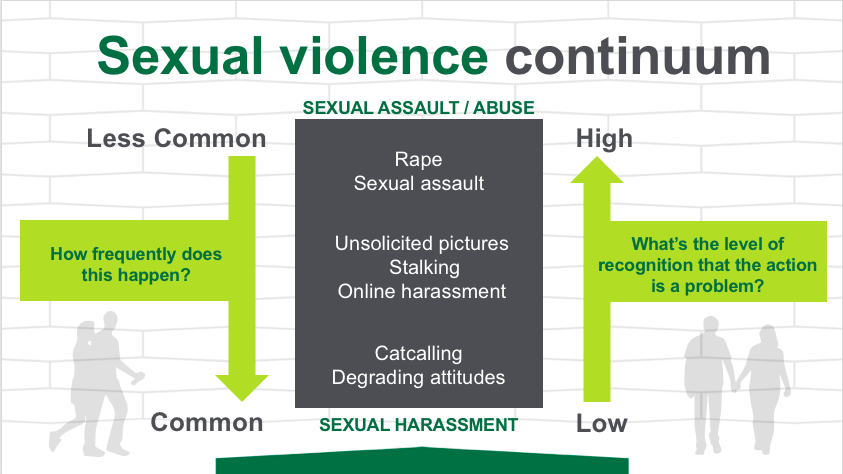Seek help and support after experiencing sexual violence
Sexual violence
Sexual violence is an umbrella term that includes sexual harassment, sexual abuse and sexual assault. Sexual violence affects people of all ages, genders, and sexual orientations.
Sexual harassment
Sexual abuse
Sexual assault
Sexual violence continuum

Sexual violence can be viewed along a continuum where there is a progression of beliefs and attitudes that contribute to the justification of sexual violence.
Degrading attitudes and beliefs justify our verbal expressions and actions and if those expressions and actions are left unchallenged, they can result in sexual harassment and can further serve to normalize and justify sexual assault.
Sexual harassment happens more frequently than sexual assault but is less recognized. Whereas sexual assault happens less frequently but is more recognized.
Here at the University of Saskatchewan, we want to make actions more recognizable and unacceptable at all levels of the continuum.
Myths
Underreporting of sexual violence is due in part to rape myths.
Rape myths include false beliefs about sexual violence that largely place the blame of being assaulted on the survivor while absolving the perpetrator.
These myths suggest that survivors bring about their victimization through their actions. For example, the clothes they wear, drinking alcohol, and even being alone.
Rape myths serve to support a culture of sexual violence and make it even more difficult for survivors to report.
The "stranger danger" is a common perception of sexual violence—it helps to spread the belief that if sexual violence is not committed by a stranger in the dark, when we are alone—then it cannot be sexual violence.
If we use these myths to explain why other violent crimes happen—it becomes very clear how ridiculous they are. The movie James is Dead does just that.
To learn more about rape myths, visit the Sexual Assault and Information Centre.
Prevention
Sexual violence is a significant public health problem. In Canada, one out three women and 1 out of 8 men will experience sexual violence. We also know that Indigenous individuals and people of colour are disproportionately impacted by sexual violence.
It takes a community-wide response to change the culture and end sexual violence. We all have a role to play. Be the difference and help us create a campus free of sexual violence.
Intervention strategies
Bystanders are individuals who witness situations and, by their presence, may have the opportunity to help, do nothing, or even contribute to the negative behaviours. Prosocial bystanders are individuals who intervene to impact the situation positively. Being a prosocial bystander by recognizing a bad situation and learning to safely intervene is also important for sexual violence prevention. There are different ways you can intervene.
In this episode of the Be Well at USask podcast, guest host Tracy Spencer discusses sexual violence prevention and response with two USask students.
Consent
Understanding consent and having open communication in all relationships are key to preventing sexual violence. It is essential to obtain a voluntary, sober, and enthusiastic "yes" to engage in any sexual activity. Consent needs to be clear, coherent, ongoing, willing, and informed. Consent to one kind of sexual activity does not mean that consent is given to another sexual activity. Consent is not continuous and can be revoked at any time.
A person is unable to provide consent if they are pressured, forced, threatened, bribed, and/or affected by drugs or alcohol.
Educate yourself
Sexual Violence Prevention and Response online course
This online course includes four self-paced modules hosted on Canvas. The first module outlines sexual violence and common myths. The second module defines sexual consent and explores ways to practice it. The third module discusses how to intervene in situations of sexual violence and factors that influence intervention behaviours. The last module explores the impacts of sexual violence, barriers to disclosure, and how to support a survivor when they disclose their experience.
There are two versions of this course, one for faculty and staff and one for students. Both are eligible for a certificate of completion and students can also apply for a course curricular record.
Bringing in the Bystander workshop
This bystander intervention workshop is highly interactive and uses a community responsibility approach rather than focusing strictly on the roles of perpetrator and victim. It teaches bystanders how to safely intervene in instances where sexual violence is occurring or likely to occur as well as the culture that surrounds it.
Workshops take place throughout the year and are advertised on the student events calendar. Contact student.outreach@usask.ca for more information or to request a workshop for your group.
USSU Women's Centre
The USSU Women’s Centre takes a vibrant and proactive approach to educating and informing the campus community about issues affecting women. They strive to provide a safe and positive environment to promote equality while recognizing and celebrating differences within our diverse and dynamic community.
During Sexual Violence Awareness Week, the USSU Women's Centre organizes programming, which is promoted on their social media accounts.

